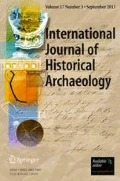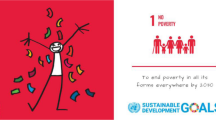Abstract
The Danish trade monopoly of the seventeenth and eighteenth centuries resulted in the implementation of strict regulations and controls on textile production, the introduction of weaving workshops equipped with new horizontal looms, and a deliberate attempt to phase out the production of homespun cloth on the warp-weighted loom. What was the fate of homespun cloth in this era of introduced industrialization in Iceland? Archaeological textile collections from Iceland’s early modern period are abundant though understudied. This paper reports current research on these collections and suggests that homespun cloth did not die out in the late medieval period, but that it continued into the seventeenth and eighteenth centuries, declining slowly thereafter. Moreover, homespun cloth of the early modern period evolved into something that was structurally different than its earlier medieval version, possibly in response to increased climatic fluctuations during the Little Ice Age.






Similar content being viewed by others
Notes
In single yarns the fibers through the process of spinning or twisting are made to overlap each other and the addition of new fibers adds to the length creating a single strand of yarn (Minar 2001). When two or more strands of yarn are twisted together this is referred to as “plied” and is generally done in the opposite direction to the initial spin.
References
Adovasio, J. M. (1986). Artifacts and ethnicity: Basketry as indicator of territoriality and population movements in the prehistoric Great Basin. In Condie, C. J., and Fowler, D. D. (eds.), Anthropology of the Desert West: Essays in Honor of Jesse D. Jennings, University of Utah Press, Salt Lake City, pp. 43–88.
Bender Jørgensen, L. (1992). North European Textiles Until AD 100, Aarhus Universitetsforlag, Aarhus.
Bender Jørgensen, L. (2003). Scandinavia, AD 400–1000. In Jenkins, D. (ed.), The Cambridge History of Western Textile I, Cambridge University Press, Cambridge, pp. 132–138.
Carr, C., and Maslowski, R. F. (1995). Cordage and fabrics: Relating form, technology and social processes. In Carr, C., and Neitzel, J. R. (eds.), Style, Society, and Person: Archaeological and Ethnological Perspectives, Plenum Press, New York, pp. 298–343.
Crowfoot, E., Pritchard, F., and Staniland, K. (2001). Textiles and Clothing 1150–1450: Medieval Finds from Excavation in London, Boydell Press, London.
Dennis, A., Foote, P., and Perkins, R. (1980). Laws of Early Iceland, Grágás I, University of Manitoba Press, Winnipeg.
Dennis, A., Foote, P., and Perkins, R. (2002). Laws of Early Iceland, Grágás II, University of Manitoba Press, Winnipeg.
Drooker, P. B. (1992). Mississippian Village Textiles at Wickliffe, University of Alabama Press, Tuscaloosa.
Dugmore, A. J., Keller, C., and McGovern, T. H. (2007). Norse Greenland settlement: reflections on climate change, trade, and the contrasting fates of human settlements in the North Atlantic islands. Arctic Anthropology 44: 12–36.
Eggertsson, Þ. (2005). Imperfect Institutions; Possibilities and Limits of Reform, University of Michigan Press, Ann Arbor.
Eldjárn, K., Christie, H., and Steffensen, J. (1988). Skálholt: Fornleifarannsóknir 1954–1958, Lögberg, Reykjavík.
Gelsinger, B. E. (1981). Icelandic Enterprise: Commerce and Economy in the Middle Ages, University of South Carolina Press, Columbia.
Hayeur Smith, M. (2012a). Weaving wealth: Cloth and trade in Viking Age and Medieval Iceland. In Huang, A., and Jahnke, C. (eds.), Textiles and Economy. Production and Trade of Textiles, The Central and Northern Europe as Example. Danish National Research Foundation, Centre for Textile Research, Copenhagen, forthcoming.
Hayeur Smith, M. (2012b). Dress, cloth and the farmer’s wife: Textiles from Ø172 Tatsipataakilleq Greenland with comparative data from Iceland. In Arneborg, J., McGovern, T. H., and Nyegaard G. (eds). Resources, Mobility, and Cultural Identity in Norse Grønland AD 980–1450: The Vatnahverfi-Project, 2005–2010. Publications of the National Museum, Studies in Archaeology and History (Version: 14-11-2011), Copenhagen, forthcoming.
Hayeur Smith, M. (2012c). Textiles from the 1988 Bessastaðir excavation. In Ólafsson, G. (ed.), Bessastaðarannsokn 1988, Skýrslur Þjóðminjasafn Íslands, 2012, Reykjavík, forthcoming.
Hjálmarsson, J. R. (1993). History of Iceland: From the Settlement to the Present Day, Iceland Review, Reykjavík.
Hoffman, M. (1974). The Warp-Weighted Loom: Studies in the History and Technology of an Ancient Implement, Norwegian Research Council for Science and the Humanities, Oslo.
Johnson, W. C. and Speedy, D. S. (1991). Cordage Twist Direction as a Tool in Delineating Territorial Boundaries and Demonstrating Population Continuity During the Late Prehistoric Periods in the Upper Ohio River Valley. Paper presented at the Annual Meeting of the Middle Atlantic Archaeological Conference, Ocean City, MD.
Kuttruff, J. T. (1988). Textile Attributes and Production Complexity as Indicators of Caddoan Status Differentiation in the Arkansas Valley and Southern Ozark Regions. Doctoral dissertation, Ohio State University, Columbus.
Lucas, G., (2002). Skálholt 2002, Framvinduskýrslur/Interim Report No.1. Forleifastofnun Íslands, FS191-02131, Reykjavík.
Lucas G. (2005). Skálholt 2005, Framvinduskýrslur/Interim Report No.4. Forleifastofnun Íslands, FS314-02134, Reykjavík.
Lucas, G. (2010). The tensions of modernity: Skálholt during the 17th and 18th centuries. Journal of the North Atlantic 1: 75–88.
Lucas, G., and Snæsdóttir, M. (2006). Archaeologies of modernity in the land of the sagas. Medeltidsarkeologisk Tidskrift 3: 5–18.
Mann, M. E., Zhang, Z., Rutherford, S., Bradley, R. S., Hughes, M. K., Shindell, D., Ammann, C., Faluvegi, G., and Ni, F. (2009). Global signature and dynamical origins of the Little Ice Age and Medieval climate anomaly. Science 326: 1256–1260.
Minar, J. (2001). Motor skills and the learning process: The conservation of cordage final twist direction in communities of practice. Journal of Anthropological Research 57: 381–405.
Morris, W. (1969). Icelandic Journals, Centaur Press, Fontwell.
Munro, J. (2003). Medieval woollens: Textiles, technology, and industrial organisation, c. 800–1500. In Jenkins, D. (ed.), Cambridge History of Western Textiles I, Cambridge University Press, Cambridge, pp. 181–227.
Ordoñez, M. T. (2011). Icelandic Textile Report. Unpublished report, Department of Textiles, Design and Fashion Merchandising, University of Rhode Island, Kingston.
Ordoñez, M. T. (2012). Reykholt Textile Analysis Report, Unpublished report, Department of Textiles, Design and Fashion Merchandising, University of Rhode Island, Kingston.
Østergård, E. (2004). Woven into the Earth: Textiles from Norse Greenland, Aarhus University Press, Aarhus.
Oswald, E. J. (1881). By Fell and Fjord, or Scenes and Studies in Iceland, William Blackwood and Sons, Edinburgh.
Petersen, J. B., and Wolford, J. A. (2000). Spin and twist as cultural markers: A New England perspective on Native fiber industries. In Drooker, P. B., and Webster, L. D. (eds.), Beyond Cloth and Cordage: Archaeological Textile Research in the Americas, University of Utah Press, Salt Lake City, pp. 101–117.
Robertsdóttir, H. (2008). Wool and Society: Manufacturing Policy, Economic Thought and Local Production in 18th-Century Iceland, Makadam, Göteborg.
Rothstein, N. (2003). Silk in the early modern period c. 1500–1780. In Jenkins, D. (ed.), Cambridge History of Western Textiles I, Cambridge University Press, Cambridge, pp. 528–561.
Smith, K. P. (2009). Preliminary Investigations at Gilsbakki, Borgarbyggð, Western Iceland: 2008 Season, Haffenreffer Museum of Anthropology, Brown University, Providence, RI.
Smith, K. P. (2012a). Investigations at Gilsbakki, Borgarbyggð; Western Iceland: 2009 Field Season, Haffenreffer Museum of Anthropology, Brown University, Providence, RI.
Smith, K. P. (2012b). Living in the Shadows of Glory; Gilsbakki and Representations of Power in Post-medieval Iceland. Manuscript in preparation.
Snæsdóttir, M. (2009). Húsin í Skálholti. In Ólafsson, G., and Kristjánsdóttir, S. (eds.), Endurfundir: Fornleifarannsóknir styrktar af Kristnihátiðarsjóði 2001–2005, Þjóðminjasafn Íslands, Reykjavík, pp. 70–79.
Sveinbjarnardóttir, G. (2006). Reykholt: A centre of power—the archaeological evidence. In Mundall, E. (ed.), Reykholt som Makt- or Lærdomssenter I den Islandske og Nordiske Kontekst (Reykholt as a Centre of Power and Learning in an Icelandic and Nordic Context), Reykholt, Snorrastofa, pp. 25–42.
Thirsk, J. (2003). Knitting and knitwear. In Jenkins, D. (ed.), Cambridge History of Western Textiles I, Cambridge University Press, Cambridge, pp. 562–584.
Þorláksson, H. (1991). Vaðmál og verðlag: vaðmál í útanlandsviðskiptum og búskap Íslendinga á 13. og 14. öld. Háskóli Íslands, Reykjavík.
Acknowledgments
This research was made possibly with funds from the National Science Foundation, Arctic Social Sciences, Polar Programs—award no.1023167, and with help from the following institutions and individuals: Haffenreffer Museum of Anthropology, Brown University; National Museum of Iceland; Fornleifastofnun Íslands; Department of Textiles, Design and Fashion Merchandising, University of Rhode Island; Gavin Lucas for kindly sharing the unpublished material from Skálholt; Kevin P. Smith, my husband, for all of his help and insights into the site of Gilsbakki, for his discussions and thoughts on the data and for having helped in the different stages of editing the paper; Guðrún Sveinbjarnardóttir for allowing me to work and publish material on Reykholt, Oscar Aldred for help with the Reykholt phasing and data, Margaret T. Ordoñez; Guðmundur Ólafsson for help with Bessastaðir; Lilja Árnárdóttir and the curatorial staff at the National Museum of Iceland for their help with accessing collections.
Author information
Authors and Affiliations
Corresponding author
Rights and permissions
About this article
Cite this article
Smith, M.H. “Some in Rags and Some in Jags and Some in Silken Gowns”: Textiles from Iceland’s Early Modern Period. Int J Histor Archaeol 16, 509–528 (2012). https://doi.org/10.1007/s10761-012-0190-1
Published:
Issue Date:
DOI: https://doi.org/10.1007/s10761-012-0190-1




